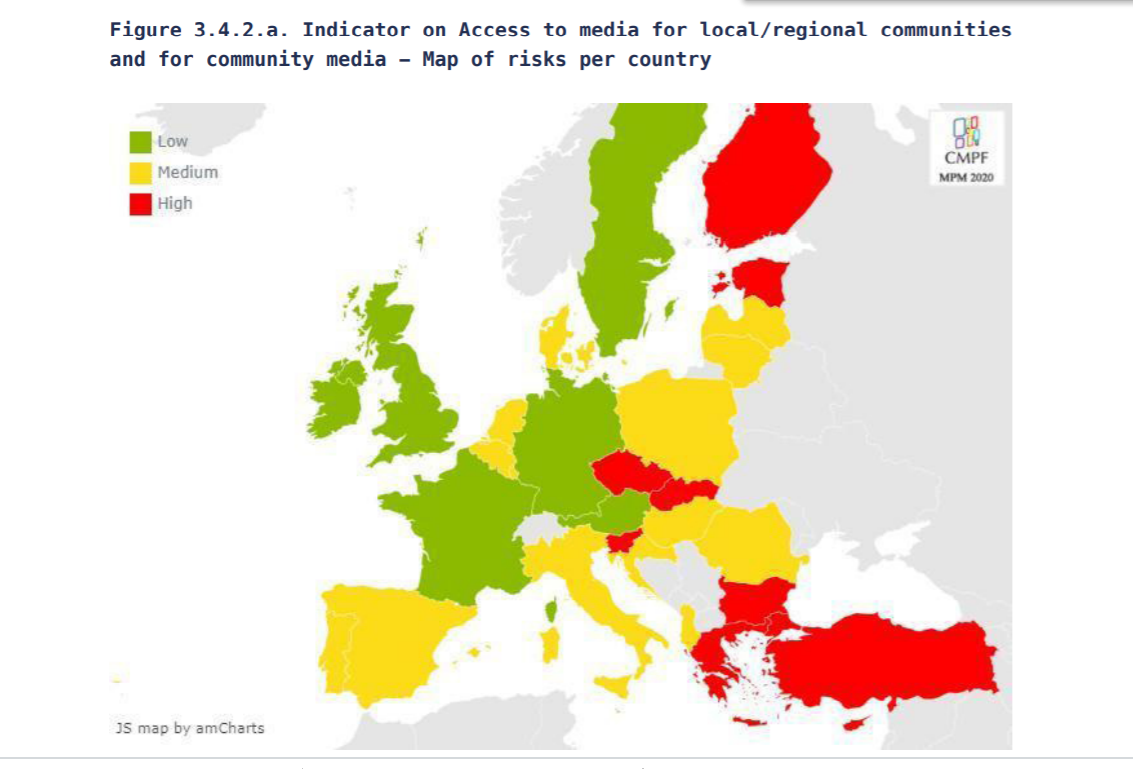1. Raziskava Stanje skupnostnih medijev v Evropski uniji, objavljena 26. septembra 2007 (The state of community media in the European Union - https://www.europarl.europa.eu/thinktank/en/document.html?reference=IPOL-CULT_ET%282007%29408943)
This study was requested by the European Parliament's Committee on Culture and Education Author: Kern European Affairs (KEA), Belgium
"Community media" are non-profit, open to or accountable to the community that they serve and mainly staffed by volunteers. As such, they form a separate sub-group within the media sector. The purpose of this study is to outline how Community Media are organised across the EU and to underline their distinctive contribution to media pluralism and other socio-political objectives.
Partial recognition of the sector: In Slovenia, Article 80 of the 2006 Media Act recognises student radio as CM: “A student organisation may be the publisher of a radio and/or television station if the majority of the programming is created and disseminated by students and is primarily aimed at a student audience, and if the surplus of revenues over expenditure is used only for executing the activities for which it was founded, in accordance with the act governing the operation and activities of students’ self-managed communities in Slovenia and its basic legal act”17. However, this definition of student radio falls under the overarching category of “special purpose” radio, which also includes other commercial local radio stations. As a result, commercial local operators, as well as CM initiatives, compete for the same radio frequencies. They also compete for subsidies from the local television fund, which is financed by 3% of the public service licence fee. The Slovenian situation illustrates how legislation that is not fully developed and does not clarify the special purpose of CM may fail in bringing effective benefits to the sector.
2. Promoting social cohesion: the role of community media
Report prepared for the Council of Europe’s Group of Specialists on Media Diversity (MC-S-MD)
by Peter Maynard Lewis
Media and Information Society Division, Directorate General of Human Rights and Legal Affairs
Council of Europe, July 2008
3. Monitoring Media Pluralism in the Digital Era: Report 2020 - Application of the Media Pluralism Monitor in the European Union, Albania and Turkey in the years 2018-2019.
https://cadmus.eui.eu/bitstream/handle/1814/67828/MPM2020-PolicyReport.pdf
European University Institute, Centre for Media Pluralism and Media Freedom, Robert Schuman Centre for Advanced Studies, Research Project Report, RSC/Centre for Media Pluralism and Media Freedom, July 2020
In the MPM, the community media are defined as being those media that are non-profit and that are accountable to the community that they seek to serve. They are open to participation by the members of the community for the creation of content. As such, they are a distinct group within the media sector, alongside commercial and public media.
Community media are addressed at specific target groups and social benefit is their primary concern. This MPM indicator assesses whether local and regional communities are guaranteed access to the media, both in terms of legal safeguards and of policy or financial support. It also covers community media, both from the point of view of the legal and practical guarantees of access to media platforms and independence, as well as in terms of policy measures.
In the majority of the countries, community media are not recognised as a unique category by media law, and their sustainability and independence, including access to subsidies, is often guarded only by the general provisions of a media law.

4. Študija javna vrednost nekomercialnega skupnostnega radiodifuznega oddajanja v Avstriji
Studie "Public Value des Nichtkommerziellen Rundfunkfonds" https://www.rtr.at/de/inf/StudiePublicValue-2020
Autor: Dr. Josef Seethaler (CMC/ÖAW), Mag. Helmut Peissl (COMMIT)
Datum: 06. 07. 2020
Povzetek v angleščini:
Public value of non-commercial community broadcasting in Austria
5. Večjezični in lokalni. Nekomercialno oddajanje in javna vrednost v Avstriji ("Multilingual and Local. Non-commercial Broadcasting and Public Value in Austria") iz leta 2010
Helmut Peissl, Petra Pfisterer, Judith Purkarthofer, Brigitta Busch 2010
5. Nekomercialna radiodifuzija v Avstriji in Evropi (Nichtkommerzieller Rundfunk in Österreich und Europa https://www.rtr.at/de/inf/SchriftenreiheNr32008) iz leta 2008
Studie 1: 10 Jahre Freies Radio in Österreich Offener Zugang, Meinungsvielfalt und soziale Kohäsion – Eine explorative Studie Mag. a Judith Purkarthofer Mag. a Petra Pfisterer Univ.-Doz. in Mag. a Dr. in Brigitta Busch
Studie 2: Community Medien in Europa Rechtliche und wirtschaftliche Rahmenbedingungen des dritten Rundfunksektors in 5 Ländern
Helmut Peissl, Otto Tremetzberger
6. Predstavitev pristopa družbenih koristi do skupnostnih radijskih postaj: Zbornik zgodb (Introducing a Social Benefits approach to Community Radio: A Compendium of Stories)
Submitted to:
CRAOL: Community Radio Ireland and Broadcasting Authority of Ireland.
Researched and compiled by
Seán Ó Siochrú and Paul Butler, Nexus Research Cooperative
April 2020
https://www.bai.ie/en/media/sites/2/dlm_uploads/2020/05/20200429_Story_Compen_FINAL_LB.pdf
What really differentiates community media from their local commercial counterparts is that they see themselves, from their foundation, as part of the community. They do not just serve the community, or reflect the interests of the community, they engage directly with the community and the community engages directly with them – they are inseparable. It is not just about capturing the attention of listeners, it is about listening to the community, being part of the community by engaging in activities, amplifying the voices of diverse groups in the community, opening a space for volunteers to take part directly and indeed to manage and run the station. Most of all it is about contributing to the overall social benefit of the community, as part of and engaging with the wider local empowerment and development infrastructure.